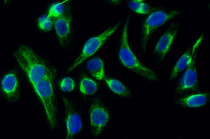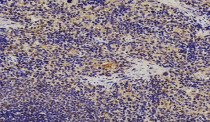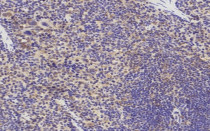ARG67146
anti-p38 MAPK antibody
anti-p38 MAPK antibody for ICC/IF,IHC-Formalin-fixed paraffin-embedded sections,Western blot and Human,Mouse,Rat
Cancer antibody; Immune System antibody; Signaling Transduction antibody; NF-kB Activation Study antibody
概述
| 产品描述 | Rabbit Polyclonal antibody recognizes p38 MAPK |
|---|---|
| 反应物种 | Hu, Ms, Rat |
| 预测物种 | Fsh, Pig |
| 应用 | ICC/IF, IHC-P, WB |
| 宿主 | Rabbit |
| 克隆 | Polyclonal |
| 同位型 | IgG |
| 靶点名称 | p38 MAPK |
| 抗原物种 | Human |
| 抗原 | Synthesized peptide corresponding to a.a. 147-196 of Human p38 MAPK. |
| 偶联标记 | Un-conjugated |
| 別名 | MAPK14; Mitogen-Activated Protein Kinase 14; PRKM14; PRKM15; CSBP1; CSBP2; CSPB1; Mxi2; P38; Mitogen-Activated Protein Kinase P38 Alpha; MAX-Interacting Protein 2; CSAID-Binding Protein; MAP Kinase P38 Alpha; P38 MAP Kinase; MAP Kinase 14; EC 2.7.11.24; SAPK2A; CSBP; Cytokine Suppressive Anti-Inflammatory Drug Binding Protein; Cytokine Suppressive Anti-Inflammatory Drug-Binding Protein; P38 Mitogen Activated Protein Kinase; Stress-Activated Protein Kinase 2A; Stress-Activated Protein Kinase 2a; MAP Kinase Mxi2; MAP Kinase MXI2; P38alpha Exip; EC 2.7.11; P38ALPHA; MAPK 14; SAPK2a; EXIP; MXI2; RK |
应用说明
| 应用建议 |
|
||||||||
|---|---|---|---|---|---|---|---|---|---|
| 应用说明 | * The dilutions indicate recommended starting dilutions and the optimal dilutions or concentrations should be determined by the scientist. |
属性
| 形式 | Liquid |
|---|---|
| 纯化 | Affinity purified |
| 缓冲液 | PBS with 50% glycerol, 0.5% BSA and 0.02% sodium azide |
| 抗菌剂 | 0.02% Sodium azide |
| 稳定剂 | 50% glycerol and 0.5% BSA |
| 存放说明 | For continuous use, store undiluted antibody at 2-8°C for up to a week. For long-term storage, aliquot and store at -20°C or below. Storage in frost free freezers is not recommended. Avoid repeated freeze/thaw cycles. Suggest spin the vial prior to opening. The antibody solution should be gently mixed before use. |
| 注意事项 | For laboratory research only, not for drug, diagnostic or other use. |
生物信息
| 数据库连接 | |
|---|---|
| 基因名称 | MAPK14 |
| 全名 | Mitogen-Activated Protein Kinase 14 |
| 背景介绍 | The protein encoded by this gene is a member of the MAP kinase family. MAP kinases act as an integration point for multiple biochemical signals, and are involved in a wide variety of cellular processes such as proliferation, differentiation, transcription regulation and development. This kinase is activated by various environmental stresses and proinflammatory cytokines. The activation requires its phosphorylation by MAP kinase kinases (MKKs), or its autophosphorylation triggered by the interaction of MAP3K7IP1/TAB1 protein with this kinase. The substrates of this kinase include transcription regulator ATF2, MEF2C, and MAX, cell cycle regulator CDC25B, and tumor suppressor p53, which suggest the roles of this kinase in stress related transcription and cell cycle regulation, as well as in genotoxic stress response. Four alternatively spliced transcript variants of this gene encoding distinct isoforms have been reported. [provided by RefSeq, Jul 2008] |
| 生物功能 | Serine/threonine kinase which acts as an essential component of the MAP kinase signal transduction pathway. MAPK14 is one of the four p38 MAPKs which play an important role in the cascades of cellular responses evoked by extracellular stimuli such as proinflammatory cytokines or physical stress leading to direct activation of transcription factors. Accordingly, p38 MAPKs phosphorylate a broad range of proteins and it has been estimated that they may have approximately 200 to 300 substrates each. Some of the targets are downstream kinases which are activated through phosphorylation and further phosphorylate additional targets. RPS6KA5/MSK1 and RPS6KA4/MSK2 can directly phosphorylate and activate transcription factors such as CREB1, ATF1, the NF-kappa-B isoform RELA/NFKB3, STAT1 and STAT3, but can also phosphorylate histone H3 and the nucleosomal protein HMGN1. RPS6KA5/MSK1 and RPS6KA4/MSK2 play important roles in the rapid induction of immediate-early genes in response to stress or mitogenic stimuli, either by inducing chromatin remodeling or by recruiting the transcription machinery. On the other hand, two other kinase targets, MAPKAPK2/MK2 and MAPKAPK3/MK3, participate in the control of gene expression mostly at the post-transcriptional level, by phosphorylating ZFP36 (tristetraprolin) and ELAVL1, and by regulating EEF2K, which is important for the elongation of mRNA during translation. MKNK1/MNK1 and MKNK2/MNK2, two other kinases activated by p38 MAPKs, regulate protein synthesis by phosphorylating the initiation factor EIF4E2. MAPK14 interacts also with casein kinase II, leading to its activation through autophosphorylation and further phosphorylation of TP53/p53. In the cytoplasm, the p38 MAPK pathway is an important regulator of protein turnover. |
| 细胞定位 | Cytoplasm, Nucleus. [UniProt] |
| 研究领域 | Cancer antibody; Immune System antibody; Signaling Transduction antibody; NF-kB Activation Study antibody |
| 预测分子量 | 41 kDa |
| 翻译后修饰 | Acetylation, Phosphoprotein, Ubl conjugation. [UniProt] |
检测图片 (5) Click the Picture to Zoom In
-
ARG67146 anti-p38 MAPK antibody IHC-P image
Immunohistochemistry: Human spleen stained with ARG67146 anti-p38 MAPK antibody at 1:200 dilution.
-
ARG67146 anti-p38 MAPK antibody ICC/IF image
Immunofluorescence: HeLa stained with ARG67146 anti-p38 MAPK antibody at 1:200 dilution.
-
ARG67146 anti-p38 MAPK antibody WB image
Western blot: 3T3-UV stained with ARG67146 anti-p38 MAPK antibody at 1:1000 dilution.
-
ARG67146 anti-p38 MAPK antibody IHC-P image
Immunohistochemistry: Rat spleen stained with ARG67146 anti-p38 MAPK antibody at 1:200 dilution.
-
ARG67146 anti-p38 MAPK antibody IHC-P image
Immunohistochemistry: Mouse spleen stained with ARG67146 anti-p38 MAPK antibody at 1:200 dilution.










